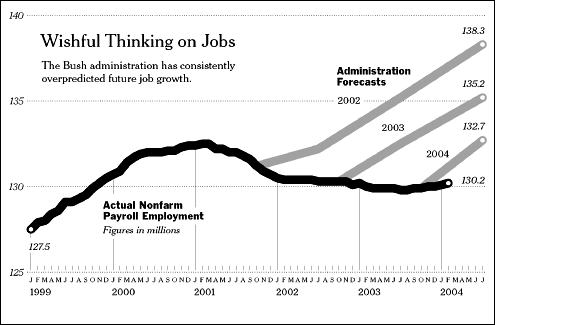12 March 2004, Paul Krugman, The New York Times
We don't know why so many people have stopped looking for jobs, but it probably has something to do with the fact that jobs are so hard to find: 40 percent of the unemployed have been out of work more than 15 weeks, a 20-year record. In any case, the administration should feel grateful that so many people have dropped out. As the Economic Policy Institute points out, if they hadn't dropped out, the official unemployment rate would be an eye-popping 7.4 percent, not a politically spinnable 5.6 percent.

9 March 2004, Paul Krugman, The New York Times
Despite a string of dismal employment reports, the administration insists that its economic program, which has relied entirely on tax cuts focused on the affluent, will produce big job gains any day now. Should we believe these promises?
Each February, the Economic Report of the President forecasts nonfarm payroll employment — generally considered the best measure of job growth — for the next several years. The black line in the chart above (inspired by a joint report from the Economic Policy Institute and the Center on Budget and Policy Priorities) shows the actual performance of employment, both before and after its peak in March 2001. The gray lines show the forecasts in the 2002, 2003 and 2004 reports. Notice that the February 2004 forecast, which, as in previous years, is based on data only through the preceding October, is already 900,000 jobs too high.
Economic forecasting isn't an exact science, but wishful thinking on this scale is unprecedented. Nor can the administration use its all-purpose excuse: all of these forecasts date from after 9/11. What you see in this chart is the signature of a corrupted policy process, in which political propaganda takes the place of professional analysis.
©The New York Times





